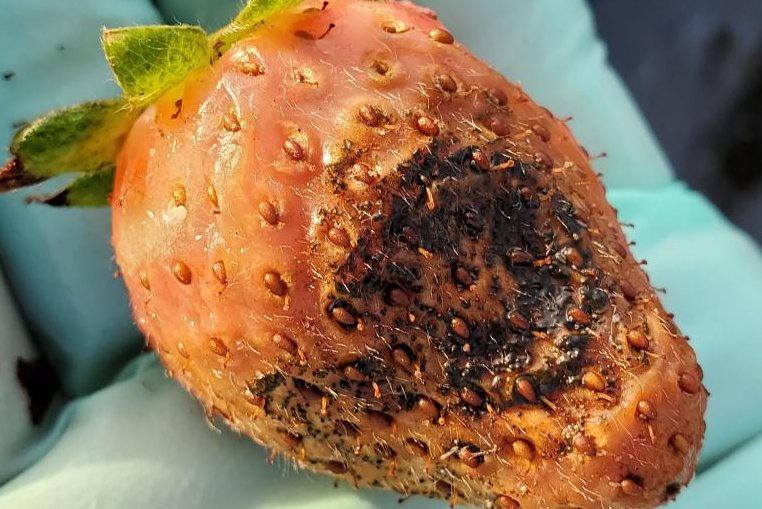1 of 3 | A strawberry shows damage this month from an aggressive new strain of pestalotiopsis fungus at a farm east of Tampa, Fla. Photo courtesy of the University of Florida
ORLANDO, Fla., Jan. 24 (UPI) -- A new strain of a deadly fungus has wiped out part of Florida's strawberry crop this winter, causing perhaps millions of dollars in losses and raising fears of a new permanent pest.
First discovered in the Plant City area east of Tampa -- the center of strawberry production in the state -- the fungus took hold just as harvest season was beginning in December.
Consumers around the country felt the impact because Florida is the only place in the United States with a major winter crop.
The pestalotiopsis fungus invaded up to one-fourth of Florida's 10,000 acres of strawberries and about half of its current organic strawberry acreage, said Natalia Peres, a plant pathologist with University of Florida's agriculture research agency.
While hundreds of acres of plants were lost, other areas suffered partial losses of the fruit or were saved by fungicide spraying.
The actual financial impact is not yet available, but growers of the delicate specialty crop invest at least $15,000 per acre, according to state agriculture statistics.
The average retail price of organic strawberries spiked because of shortages to $6.23 per pound on Jan. 11 from $3.99 per pound during mid-December, according to the U.S. Department of Agriculture.
The fungus causes the fruit, leaves and roots to turn brown with rot, and farmers are worried that the disease might have settled permanently in Florida. They hope it won't reappear, but the magnitude of infestation makes it more likely it will be a long-lasting problem.
"We lost maybe 80 acres of the organic. It's definitely a setback, but it's not a knockout punch for us," said Gary Wishnatzki, a farmer in the Plant City area. "Conditions have improved, so we're hopeful."
At $15,000 per acre, that means Wishnatzki is dealing with a front-end loss of around $1.2 million.
His company, Wish Farms, grows about 600 acres of strawberries, 200 acres of which are organic, and he leases another 1,200 acres to other strawberry operations. According to University of Florida, an acre can yield about 32,000 pounds of organic strawberries, meaning Wishnatzi lost at least 2.5 million pounds of berries.
"We had warm and rainy weather for a few days in late December, and that allowed this new strain of fungus to flourish," said Peres, a professor of plant pathology. "It arrived in Florida on a young plant brought in from a nursery."
It hasn't been determined where the fungus originated, she said. Since young plants generally are imported from California, North Carolina and Canada, Peres is working with researchers in those areas to identify the source.
Peres said she has been seeking a way to control the fungus, especially for organic farmers who have limited choices. She is testing how samples of the fungus react to various substances, including natural botanic-based fungicides that would be allowed in organic production.
Drier weather contained further spread of the fungus as of a few days ago, said Kenneth Parker, executive director of the Florida Strawberry Growers Association.
"It really was a perfect storm for these fungus spores to spread," he said. "We were spraying and picking and moving through the wet fields for days, and that was spreading the spores."
Besides finding a fungicide that works, Peres and the growers want to learn what other types of plants and trees might host the fungus.
"We can't remove all plants from around our fields, but if we know the fungus can survive on oak trees, for example, removing some oaks might prevent having the fungus around another season," Wishnatzki said.
Florida's climate allows growing strawberries in winter, but also poses problems in terms of pests, mildew and fungus, Peres said. Because of that, little nursery production of strawberry plants exists locally.
Because of Florida's problems with pests and fungus, organic strawberry production still is relatively small compared to conventional production. The new fungus proved to have significant resistance to both organic and conventional fungicides, Peres said.
As a small, specialty crop, strawberries often not covered by farm insurance policies. Wishnatzki said that level of risk is why organic produce is more expensive.
"We are working on it as quickly as we can to come up with answers, testing different products," Peres said. "We're trying to understand if this strain will survive here."















